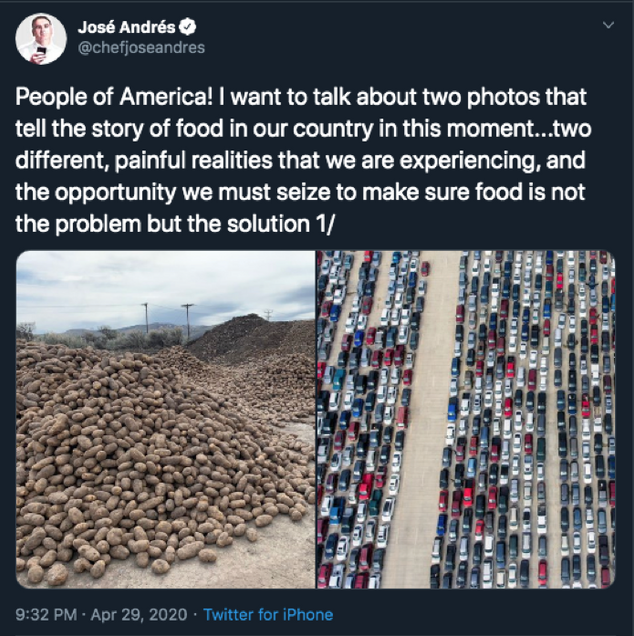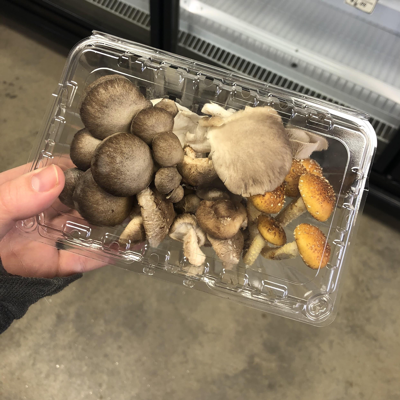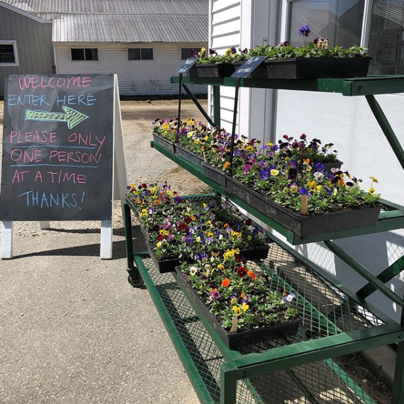COVID-19 Impact on Global Supply Chains
Gastronomy student Carolyn Holt wrote today’s post as part of her work in MET ML 641, Anthropology of Food.
It is hard to overestimate the impact that COVID-19 is having on global supply chains. Awareness of the supply chain effects may have begun with the runs on toilet paper, hand soap, and canned beans at local supermarkets, but more recent accounts of supply chain disruption communicate the scale. Vivid images from all over the country of dairy producers dumping milk and vegetables plowed back into the ground surprised people reading about increased demand at food banks, prompting indignant questions on social media. Many food banks and related food distributors have limited storage capacity for fresh produce (and fewer volunteers than ever), and farms have limited processing capabilities. As Chef José Andrés of World Central Kitchen (which specializes in disaster-response food production and distribution) pointed out on Twitter recently, “we have a food supply chain that we treat as invisible when it’s working…and only notice it when it’s not.”

What is now more obvious than ever is what scholars of famine have known for decades: there is food, and there is hunger; what’s missing is the distribution infrastructure (and political will) to connect producers with eaters. Some have argued that this moment illustrates the need for food sovereignty, and given the record sales of seedlings and seeds (and renewed interest in seed-saving) for home and community gardens it seems that many with access to land agree. But for small-scale farmers, adapting to the crisis has presented a series of challenges, and a steep learning curve.
Farmers who worked with restaurants are finding new ways to reach consumers, as some restaurants convert to grocery stores and some distributors and wholesalers pivot to home delivery. CSA shares have exploded in popularity, but most growth seems limited to farms that had CSA processing and packing capabilities before the pandemic. Some CSAs are arranged by farmers, others by coalitions, and while some are able to offer home delivery others deliver to CSA sites.


Farmers’ markets, which are (generally) better equipped than CSAs to accept federal nutrition benefits like SNAP and WIC, are subject to variable local and state regulation which has left some farmers scrambling. In efforts to negotiate social distancing guidelines, farmers’ markets have innovated: many are now “drive-thru” and some have developed online order and payment capacities to bundle purchases. This article from Boston Magazine outlines some of the options available to those in the city as of a few weeks ago.
I left Boston to shelter-at-home with family in New Hampshire after classes moved online, and a highlight of each week of social isolation has been picking up beautiful mushrooms, parsnips, and salad greens from Longview Farm’s one-at-a-time, self-service farmstand. In an effort to connect New Hampshirites to local farmers, the University of New Hampshire Cooperative Extension began developing the New Hampshire Farm Products Map, which went live a few weeks ago. The Map not only includes farm locations and crop listings, but employment opportunities and non-food items like compost, hay, and cut flowers. As spring finally comes to New Hampshire, I am looking forward to stopping by Owens Truck Farm and learning about other local producers. Other local resources include the New Hampshire Food Alliance and the Facebook pages of farmers markets.
In Everyone Eats, E. N. Anderson notes that historically, “shifts in foodways often come from ecological or economic changes,” (Anderson 2014, 109). I am hopeful that the attention to the failures of our global food systems prompted by COVID-19 will translate into renewed connection with and appreciation for local food systems and the people who create them. Whether the capacity- and community-building facilitated by innovative responses to global supply chain disruption has staying power remains to be seen.
Works Cited
Anderson, Eugene N. 2014. Everyone Eats: Understanding Food and Culture. New York: New York University Press.